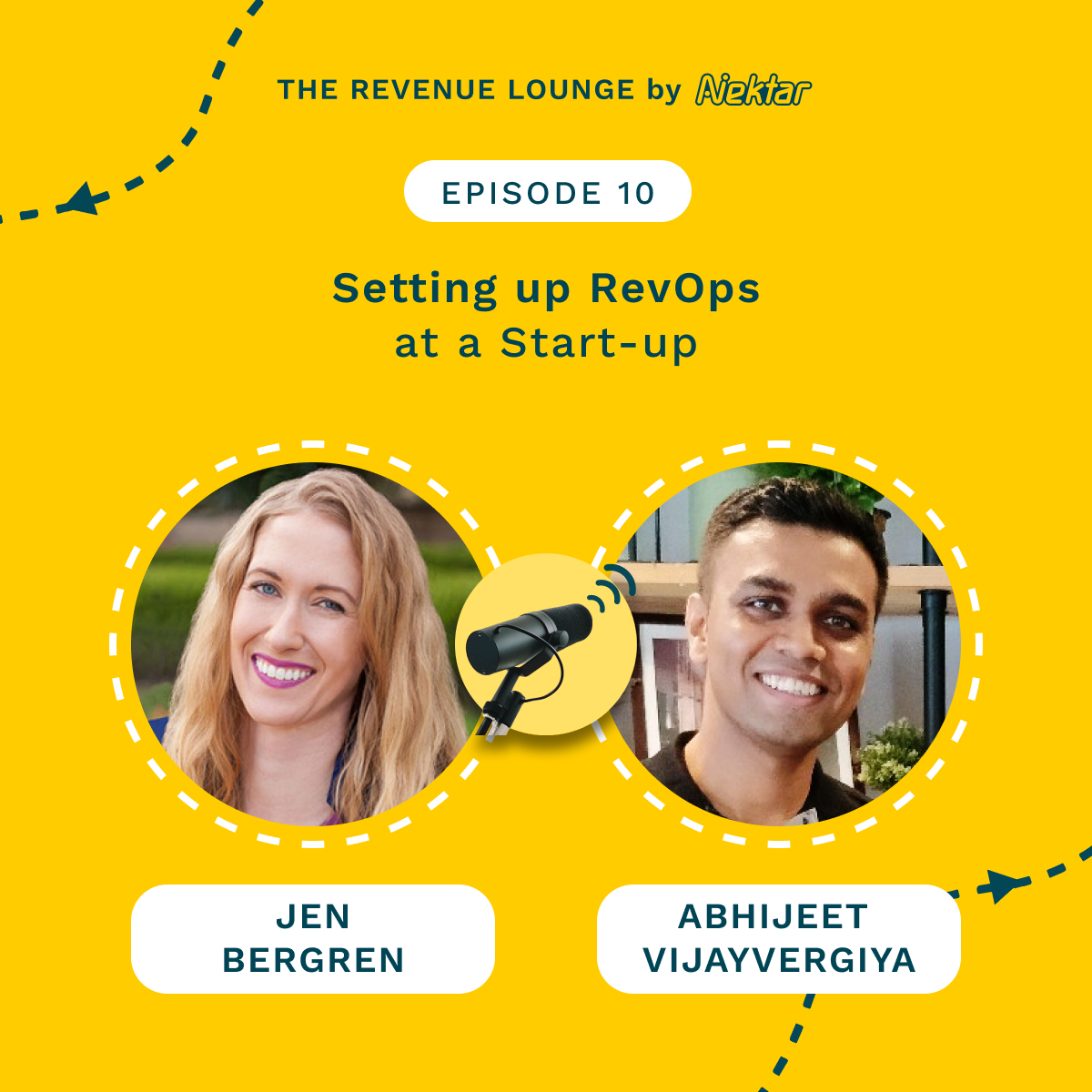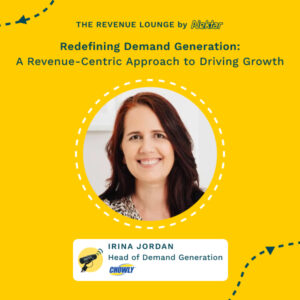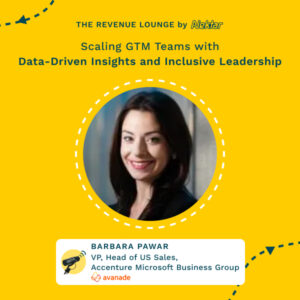Scaling GTM with a Data-First Mindset ft. Roee Hartuv
September 4, 2024
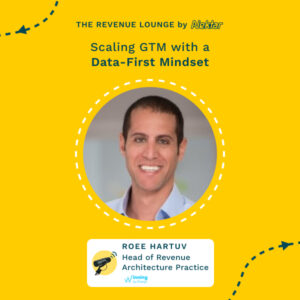
About
The Revenue Lounge
The podcast covers stories from leaders across RevOps, Sales, Customer Success, GTM, Data and Marketing about what drives these functions and what advice they would share with our listeners. With 3 seasons recorded, the podcast currently features 50+ enterprise leaders in the B2B SaaS domain. Tune in to hear from the best in the business
In this episode of The Revenue Lounge podcast, host Randy Likas interviews Roee Hartuv, Head of Revenue Architecture Practice at Winning by Design. They discuss Roee’s background, Winning by Design’s consulting offerings, the “revenue factory” concept, implementing change management, using data to drive decisions, trends in the SaaS industry, and more.
Key Discussion Points:
– Winning by Design’s consulting and training services for recurring revenue B2B companies (00:03:34)
– The “revenue factory” metaphor for designing go-to-market teams and strategies (00:09:38)
– Implementing change management to align teams to a unified goal vs working in silos (00:12:09)
– Using the “bow tie” model to standardize data and understand the customer journey (00:15:47)
– Predictions of low-efficiency SaaS companies going out of business in coming years (00:31:39)
Guest Bios:
Roee Hartuv – Head of Revenue Architecture Practice at Winning by Design. Background in computer science and sales engineering. Focuses on designing go-to-market strategies and processes.
Winning by Design – Consulting firm that helps recurring revenue B2B companies optimize their go-to-market strategies across sales, marketing, and customer success.
Key Quotes:
“When you think of it as a production line, all the go-to-market departments working together for that unified goal at the end.” (00:11:54)
“We know that in order to recoup the cost of acquisition, we need to make sure that our clients stick with us.” (00:17:05)
“Gone are the days that let’s just hire headcount and hope that they all, you know, drag along and start adding revenue.” (00:31:22)

Randy Likas (00:01.311)
Hello, everyone. Welcome to another episode of the Revenue Lounge. I am your host, Randy Likas. And today we have the pleasure of speaking with Roee Hartuv, who is the head of the Revenue Architecture Practice at Winning by Design. Roee, thank you for joining us today. So I got my first exposure to Winning by Design at the Pavilion Conference last year. Jaco was there and listening to his keynote. And since then, I’ve been a
Roee @ Winning By Design (00:17.004)
Yeah, pleasure to be here. Thank you for inviting me.
Randy Likas (00:30.909)
big fan and I’ve certainly consumed a lot of content. So I’m looking forward to this discussion. But before we kind of get into that, I would love to hear a little bit about your background, sort of how you got into Sal’s and what led you to your current role at Winning by Design.
Roee @ Winning By Design (00:47.244)
Yeah. Cool. say, I would say actually did my bachelor’s in computer science and I thought that I wanted to code. But during my studies, I heard of an opportunity of being a sales engineer. And with that in specific company that allowed me to travel a lot. combining what I do as somebody that has the computer science background, taking this and talking to clients about technical stuff while traveling the globe. So I found myself in a commercial role actually. I would consider sales engineer a commercial role, right? That’s how we see it or I see it. And from there on, I got in love in the practice of talking to customers.
Randy Likas (01:33.247)
Mm -hmm. Yep.
Roee @ Winning By Design (01:42.072)
This is what I did, naturally moved into a sales role and then climbed my ladder in different sales roles until Corona hit. Last company that I worked for as in the operational side, we lost, like we couldn’t raise the next round. And Corona and everything that changed, a friend of mine told me, hey, why don’t you come in and become a consultant?
So I did that for a while and then the opportunity to join Winning by Design, which is basically taking what I love to do with build and design, go to market strategies and practices. And I joined Winning by Design two and a years ago.
Randy Likas (02:25.631)
So why did you join? What was it that led you to the company?
Roee @ Winning By Design (02:29.698)
So.
Roee @ Winning By Design (02:33.27)
When I started to take some more leadership roles, I found myself working or I worked at early stage companies and in early stage company being a sales leader means that you need to focus a lot on the processes and design go to market strategies as well as selling. And I found myself really drawn to that aspects of the job.
I grew up doing Sandler sales or being trained on Sandler, but Winning by Design, because we take a different approach, which is more on, focus on the processes, taking scientific approaches, more of that, know, sales is a science rather than sales is an art. I find myself drawn to that. I tried to implement Winning by Design practices in the last two companies that I worked for.
And when I was a consultant, then they just published that they’re looking to have more people join as consultants. I just jumped on that opportunity.
Randy Likas (03:43.685)
Well, we’ll get into some of the core, I think, principles and foundations, I think, that Winning by Design offers, like the revenue factory and the bow tie model and things like that. for those that might not know Winning by Design, can you give us a little bit of overview in terms of what you all do, the types of companies you work with maybe, and why do people come and ask for your help?
Roee @ Winning By Design (03:54.168)
Mm
Roee @ Winning By Design (04:07.66)
Yeah, so Winning by Design, we are a go -to -market strategy company. help companies that are experiencing revenue growth to build and design best practices of go -to -market, which means acquisition, sales, all the way through customer success, a bit of marketing. So we do all that. We have two major…
Roee @ Winning By Design (04:36.789)
Offerings one is the consulting services. This is where we come in diagnose a cup doing analysis on a company and then build processes in order to improve based on what we found and we also have a training practice that they come in and train the different commercial people in their organization This is what we do in terms of the companies that we support. So we focus on b2b recurring revenue businesses Which means mostly SAS businesses
We’re used US based companies. So most of our clients are US based SAS companies. I would say companies that are in that early growth stage. So they have to have roughly 10 million in ARR. So they are past that product market fit and they are now finding their go to market fit. And this is where we come in, help them find, implement and build.
that go to market practice. Yeah, we were working anywhere between 10 million all the way to north of 1 billion so public companies as well.
Randy Likas (05:47.785)
Yeah. And so as head of the revenue architecture practice, what does that exactly mean? Are you designing a lot of the service offerings? Are you refining them? Talk to me about your role specifically.
Roee @ Winning By Design (06:01.72)
Exactly that. So under our consulting services, which we call revenue architectures, another name for a consultant, and my role is to build and continue to make progress in terms of our offerings, our models that we build. Yeah, that’s what I do, as well as, you know, also working with our clients.
So I do kind of both.
Randy Likas (06:34.601)
And just curious, what’s the commercial model at Winning By Design? What I mean by that is, do you have sales reps? Or is most of your business led by you and Jaco and some of the figureheads of the company who are developing business? Or are you fortunate to have most of your business inbound?
Roee @ Winning By Design (06:50.999)
Mm
Roee @ Winning By Design (06:56.14)
Yeah, it’s mostly inbound. Our go -to -market strategy is creating great content. And, you know, this is part of our lead generation process coming on podcasts and talking on our unique approach to designing go -to -market.
Roee @ Winning By Design (07:13.75)
Yeah, so a lot of inbounds come in. We do have salespeople because at the end of the day we do have an end. Yeah, our shell cycle, any rate between like a few weeks to a few months in which we draft what is the right solution. So we need to have a salesperson involved or lead that conversation. And of course I come in as like coming back to my original role as a sales engineer, right? Like the subject matter expert, like, okay, Mr. Client, you have a salesperson, but I want
to talk about the actual content on the actual solution that you want to get from us. So I support in that role. is, even Jaco, the founder comes in in that role. So you have the salesperson that leads the buying process. But in terms of what is the right approach, what do we need to do in order to reach that impact? This is where we come in.
Randy Likas (08:08.477)
Yeah. And I imagine there are probably some key themes when people come to you and ask for help, which is, I’m hypothesizing here, but with the downturn of the market the past couple of years and kind the end of growth at all costs, people need to grow more efficiently. And so I would imagine that’s probably one of your struggles with like.
outbound’s not working anymore, or the way we used to do it isn’t working anymore, churn with everything. Am I on the right track here? there other types? I guess the question would be, what are the key, if you were to sort of bucket the key themes in terms of when people reach out and say, need help, what would those be around?
Roee @ Winning By Design (08:49.912)
All right, it’s a fantastic question. I’d like to split between up until 2021 and from 2021. Up until 2021, I wouldn’t say it’s the one that we got the most, but the one that we like to work with the most are successful companies that have one trajectory, which is fantastic growth. Just closing around and all right, we need to double our hit count.
our sales headcount, but we don’t have processes. So Winning by Design, can you come in and help us standardize the processes? So when we hire a hundred new sellers, SDR, CS, we’ll have the right processes in place because yeah, without a process, can no longer scale. That’s not the case anymore, right? The market completely changed.
Changed and he said like no grow at all costs now Companies need to find a way to continue grow to grow but with lower costs Right the investor are saying hey figure it out because you guys still need to grow But we’re no longer allowing you guys to spend Headcount and throwing you know everything that that we saw so this is the major challenge that companies
to us today. And it all comes like when you bolt it down, it’s like, hey, we had certain growth trajectory now, when like the growth declines, our win rate is not as good as it was, ACV is dropping. In some cases, they do understand the root causes, but they call us to design the right improvement plan or in some cases,
We don’t know. It’s the market. It’s us. It’s the product. Like help us figure out what we can do within the constraints of what the investors are telling us. in order to improve that.
Randy Likas (10:59.033)
Let’s kind get into some of the concepts and things that you all promote, is let’s start with the revenue factory. What is this idea of revenue? Can you maybe explain the concept of it?
Roee @ Winning By Design (11:11.19)
Yeah. Reverend faculty is a metaphor for us and how we like.
build go -to -market teams and strategies. As a regular manufacturing company that focuses on creating more output, we believe that we need to start from that, let’s say 10 million ARR point. need to start looking at our go -to -market team as a revenue factory and a revenue factory. It’s all about output. It’s increasing the quality. And when you think of it in a revenue factor, when you go to market environment,
It’s the same thing. We need to increase the output, is in our case, recurring revenue. The quality is impact. Right? The quality of our services, of our product is the impact and the value that we bring to our customers. How do we increase that in order for them to stick around more and create more of that revenue? Now within a revenue factor, we have multiple production lines and each production line is a different go to market.
Segment and a good sorry a different go -to -market motion each go -to -market motion is tailoring to a different segment Selling a different product different region whatever the different go -to -market motions a company might have and all these production lines sum up to that output which is
Randy Likas (12:39.913)
So let me make sure I heard it right. So the production lines are the go -to -market motions. those -to -market motions, you might have sales, marketing, customer success, like different functions coming together to serve a production line. Am I getting that correct?
Roee @ Winning By Design (12:55.82)
Yeah, fantastic. You’re talking about another principle that we have. When you take and put marketing and sales and customer success and consider them as a production line, they’re working together to a unified goal is the right approach compared to what we usually see or what is happening a lot is that siloed approach, right? That this is where we see marketing is doing their own thing. They generate MQLs.
Sales are never happy with the quality of the MQLs. They push it to CS, setting outside of the ICP. So all the problems that we hear, that’s like, that’s the classical working in silos. When you think of it as a production line, all the go -to -market departments working together for that unified goal at the end.
Randy Likas (13:45.331)
And what’s the change management like to go this way? Because people have operated in silos for a very long time for a lot of reasons, different KPIs, different measurements. So I would imagine people are really on board to get started, and that change management can be difficult. So can you maybe walk me through some of the common challenges with that?
Roee @ Winning By Design (13:50.743)
Cool.
Roee @ Winning By Design (14:05.952)
Yeah, definitely. That’s our biggest challenge when we come in and work with companies. And you ask, example, when we’re talking about, let’s continue the growth, but also focus on the cost structure of things, that’s a new approach, right? But when you think of it, most sales leaders,
are compensated or their targets are only on the top line. It’s how many new ARR or how what’s the growth in terms of ARR revenue. They are hardly measured on the costs or the efficiency or productivity per rep. That’s one of the biggest challenges. had a customer, I had a discussion a few weeks ago and I shared it with the team.
Roee @ Winning By Design (15:02.22)
He completely understand this approach. And when we came in, we, we talked about, Hey, let’s focus on efficiency. Let’s look at the costs, how much it costs you to acquire new customers with this production line, the go -to -market motion or with this go -to -market motion. And one was enterprise. The other one was, was mid market SMB and enterprise, although it had much bigger deals, of course, the cost.
was much higher. The wind weight was lower, the overall cost to acquire one customer enterprise was much, much higher. And it could, when we couldn’t justify the cost compared to the ACV. And we told him double down on mid market. That’s your core market. You have a perfect fit. works there. He understood that and agreed with us, but he said like, I’m not like,
I’m not, I’m being met. He didn’t tell us directly, what was between the lines I’m being compensated on ARR. I, I, nobody, they had a significant round a few months ago. He’s like, I don’t care about the cost right now. So I’m going to throw more headcount on the enterprise in order until we find out how to do that properly. So this is probably the biggest challenge that we have.
The understanding of specifically now it’s about the cost. is where we focus a lot nowadays. And that’s the biggest challenge in terms of change management. And that’s the example that I just gave. We sometimes are not able to change the mindset.
Randy Likas (16:50.047)
So one follow -up question, and then we’ll move on to talk about the bow tie model. So what do do in that case? What do you do in the case where they’re being honest with you, or you’re hearing what they’re saying without saying it? What do you all do in those cases?
Roee @ Winning By Design (17:11.392)
Andy, I don’t have a thoughtful answer here. In that case, we tried, they told us they understand they have different priorities. I cannot as an external advisor, a consultant, I can’t find with that. All right, that’s what you want? Great. Now, with that being like the scope, here’s what I would do in order to improve your enterprise quarter market motion. So we advise
Randy Likas (17:24.541)
Yeah. Right.
Roee @ Winning By Design (17:39.212)
him on that. At the end of the day, yeah, I’m limited in my control. At the end of the day, they know the company better. They know the targets. They have the discussion with the investors. They’re leading that. can only come in with that best practices.
Randy Likas (17:55.424)
It’s the old adage, you can leave the horse to water, right? But you can’t necessarily make him drink.
Roee @ Winning By Design (17:59.863)
Yep, yep.
Randy Likas (18:01.727)
Great. Well, let’s move on to, think, another really core foundational pillar of y ‘all is which is the bow tie. Can you maybe explain conceptually what the bow tie model is and how that analogy works?
Roee @ Winning By Design (18:13.1)
Yeah. So in order to create that common go -to -market motion across the different teams, we want to introduce the bow tie. The bow tie is basically the data model or a representation of the customer journey. So the bow tie looks like a bow tie on the left side. It is the classical sales and marketing funnel just tilted out inside. So on the left, we’ve got like the marketing, the create awareness process.
the education and acquisition, the classical sales and marketing funnel. However, we say or claim that in a recurring revenue business, looking only at the classical funnel is not enough. And why is that? Because when you think of it, recurring revenue takes place outside the purview of that classical funnel. It takes place in the post cell.
So if we’re as a company, we’re only focusing on that acquisition part, we’re losing what is the most important thing, which is that recurring revenue part. And we understand, we all know that in order to recoup the cost of acquisition, we need to make sure that our clients stick with us. And the more they do, the more successful we are and the faster we grow. So we just added another part, the right side of the bow tie, as we say.
And this is the retention expansion part of things. So we break it down and let three stages on the left side, three stages on the right side. This is the onboarding, the retention and expansion parts. And again, when you see six different stages, it’s hard for me to usually have a visual, but for those of you who want, you can Google this and see it in front of your eyes, but there are different six stages, three on the left side, three on the right side.
And we have departments and when we’re big enough, have different leaders that take care or lead the teams in each of those steps. Once you have that and everybody looks at across that, this is where you start to see how companies work together, how it all comes together. And we start modeling the data based on this bow tie.
Roee @ Winning By Design (20:30.924)
This is how we can start evaluating where are the areas that we need to improve and see the correlation between one team’s performance and the other.
Randy Likas (20:42.259)
love the bow tie model and I think it makes a lot of sense. And I’m curious though for the side of the bow tie, you know the right side of the bow tie when we talk about renewal and expansion, you know I talked a lot of organizations and they’re all, their organizational design is a little bit different. What I mean by that is we’ve got customer success who manages it post sale.
but expansions are still held by the AE. Or we’ve got a dedicated renewal team who handles the renewals. The CSM tries to make sure that they can deliver value to their clients. AE focuses on new business. I’m just curious, with the bow tie model, is there a recommended organizational design that you all think works best? is that, that doesn’t really matter as much as long as we’re following the concept of the bow tie.
Roee @ Winning By Design (21:35.734)
No, I do think it matters, but there isn’t the common, like a one straight answer here. When we go to design and especially on the right side, we like to look at the cost of things. makes sense in terms of cost to your specific example, right? We know that business oriented or maybe sellers, let’s call them AEs or AMs have higher salaries than the traditional customer success managers.
So this is an expensive resource that we put in front of our customers. All right, so if that’s the case, let’s evaluate based on the ACV, the average contract value. If I’m sending 20K, probably this is 20K ACV. This is probably something that the customer success team should and could do. This is more transactional, high velocity kind of expansion motion.
But if I’m selling to enterprise 250 K deals, yeah, probably I need to really focus on that land and expand and upsell and cross which would require more of account management kind of approach. So this is a great example of how we like to look at data and not say, Hey, the best practice that we saw is that this Tim does that. And people with this background can manage that process.
Randy Likas (23:01.545)
So you talk about, and I’ve heard you say it a few times, the science side of things, right, and data. And I think those two terms come together very important. So talk to me a little bit about that. Talk to me a little bit about how you all approach looking at data when you consult. But also I want to speak, I guess part two of the question would be, what role does data play?
of data play for your clients and helping them execute against this.
Roee @ Winning By Design (23:34.946)
Yeah. So when we come in, this is how we usually start off. We take the data of our clients and put it in a bow tie, putting it in a bow tie, which is one structured way. First of all, allows us to benchmark their performance against other companies. Right? So if we all adopt a bow tie, finally we’ll be able to say, Hey, the way you measure MQLs or the way you measure
let’s say win rate or close rate or average time to close all these terminology that today there’s no standard out there. But if we adopt a bow tie, this is something that we’re promoting, then we’ll start, we’ll be able to compare apples to apples, which is not the case. So this is where we always start off. So we start looking at data and start comparing it to what we believe are the right normal win rates or lead to a
conversion, etc. Whatever we want to measure. Our analysis starts with the data. Where we’re off and where we see specifically trending lines, so your wind rate is going up or your wind rate is going down, this allows us to start honing in on the actual root causes of the problems. And then we add the…
Roee @ Winning By Design (24:58.998)
the interviews and that additional, sometimes biased information about where to start and what we need to improve. So the qualitative part of the analysis. this is, go ahead, sorry. And then we continue to measure them and track them along the way. So if we’re saying, hey, you need to take this action in order to prove this number, we keep on tracking that number and seeing if we were actually right.
Randy Likas (25:13.107)
When you, good, I’m sorry, no, please, please.
Roee @ Winning By Design (25:28.79)
is going on. And if we see an improvement and we all know this, if you do one thing and a lot of cases, it changes other adjacent numbers, right? So we need more pipeline. What happens if we increase the number of leads that marketing brings in? The quality goes down. it’s looking at data and starting to figure out how to, and this is a constantly
This is constant kind of measure. How do we continue to improve over time?
Randy Likas (26:01.373)
If you think about, so you have to go to your clients and say, this is the type of data that we need to do our work. Are there common gaps? I was going to ask what are the biggest data gaps. But I guess, as you look across organizations and across clients, is there common areas where they’ve got the biggest gaps when it comes to data?
Roee @ Winning By Design (26:20.95)
Yeah. So coming back to the both are on the right side, everything post cell, usually only fine. Even the finance people have that. Right. Cause how much, how much renewals, I don’t know. need to ask, finance because they issued the new, invoices. So I don’t know if it grew or they have that information. It’s not in our CRM. That’s one common thing. Another thing is that, sometimes we measure thing. We don’t measure the right thing or.
Yeah, some clients measure when…
Roee @ Winning By Design (26:57.922)
win rate from the SDR, because the SDR opens an opportunity or sometimes it’s post discovery call, right? So these are the different things that we constantly see. Yeah, that changes and we need to come in and actually do and help create that standardized view of the bow tie and the beta.
Randy Likas (27:21.033)
Yeah. It’s amazing to me how many organizations, you you talk to them and they say, we’re very data focused and we’re this. And then you go, how’s the quality of your data in your CRM? And they go, it’s terrible, right? Nobody ever likes data in their CRM. Yet they have to make decisions, right? They have to move the business forward despite that. And so I guess my question would be, what are your thoughts on that observation? Do you often see…
like companies have really bad low quality data, but you got to make the most of it, or it may be best practices to like try to improve data quality, because the better the data, the better I’m sure the work that you all could do.
Roee @ Winning By Design (28:01.784)
Yes, that’s right. Yeah. Here it really depends. I’ve worked with a company at 500 million ARR. They didn’t even use, they had their own CRM platform. They developed it in house. And of course the data was like, we, when we came in, I was working with, the VP of, strategy and operations and he was like, don’t even spend time looking at our CRM. It’s not worth it.
I’ll give you a few investors that they were a public company, but investor public information, take whatever you can from there. But yeah, just tell us like, start from zero. And I’m right now working with a hundred million ARR company. And I’m so impressed. Like their data is, you know, except that they don’t visualize it in a bow tie, which is like, guys, just take it one step further and make it perfect. But their data is perfect. Like I was so surprised.
They have a very strong GTM and a neighborhood team and they’re doing a fantastic job. So it really depends. Sometimes you see this, sometimes you see that.
Randy Likas (29:10.527)
Yeah. Is the quality of the data, like this company that was 500 million and they’re like, don’t even look at it. Like, is it hard that, of course it’s hard. It’s a silly question, but like in the absence of that, right? In the absence of that, what do you do? Like, you, I’m just curious, how do you consult for company like that who just doesn’t have it?
Roee @ Winning By Design (29:34.646)
Yeah. Yeah. If they don’t have data, we go and look at their enablement materials. So do you have a sales playbook? Can you share with me the sales process? And then I go interview people. I always interview. Like even when I have the data, I do the same process. But when I don’t have the data, I just jump to the next stage. And then I interview people. All right, this is the sales process. Are you actually following it? No, not really. Somebody created a playbook two years ago. really follows it. This is what I do.
Randy Likas (29:39.86)
Okay.
Randy Likas (29:46.675)
Mm
Roee @ Winning By Design (30:04.14)
Great, what’s working, what’s not.
And even if the data is low quality, there are always some insights that you can extract. Closed loss reasons, company know why they’re losing it. Even if they don’t have that and they have the terrible list of possible closed loss reasons, they do have some understanding, right? Win rate is always something that companies look. I might measure it differently, but I can see that their win rate maybe…
that’s another thing. We also like to look at trends. So even if you’re not measuring it the way we would do it, what we consider is the right way to do it. All right, let’s see the trends in your win rate. It’s going down. Why is it going down? Is it a quality issue? Is it a external kind of market is going down? Companies are no longer buying solutions like yours. So even that…
Randy Likas (30:40.456)
more about that.
Roee @ Winning By Design (31:04.856)
create some sort of insight. So it’s never really zero that the example that I gave that $500 million company. It also really helped me because I didn’t need to do any analysis. I was like, they gave me the opportunity to come in and say, Hey, these are the best practices. Let’s start building them together.
Randy Likas (31:23.875)
The data, if I’m understanding, the data was there. wasn’t sitting in a system, right? You had to go out and talk to people and qualitatively extract it from them, right? Yeah, great. So let’s talk about the clients who have worked with you. They’ve implemented the philosophies and the processes that y ‘all have had.
Roee @ Winning By Design (31:31.84)
Yeah. Yeah. Yeah.
Randy Likas (31:48.871)
What have they seen in terms of improvements? Like, let’s talk about the results of moving from whatever model that they were working under before to now following a winning by design principled approach.
Roee @ Winning By Design (31:58.814)
Yeah, so it depends on where we pinpoint at, where we found the root causes. A lot of our companies see a shorter sale cycle. That’s probably the number one thing to improve using a process.
And that’s probably the biggest change that we do when we focus on the left side. On the right side, it’s retention, but these are the two metrics that we usually are positively, positively affected by our work. But I want to say something. You can enjoy companies and our listeners can enjoy what we have developed the standards and the frameworks of recurring revenue businesses or the revenue factories that we talked about.
they don’t necessarily need our support. We have an open source kind of model. I would say 95 % of our IP is openly shared in our website. We have YouTube channels, YouTube channel and videos that explain the principles. We’ve seen a lot of great stuff and usually I like to talk to those type of people that
read a book. recently we published a revenue architect book that includes a lot of things to hear by the way behind this. And I’ve talked to people that read the book and were able to implement that by themselves. So for the listeners who are interested to learn more, there are plenty of free stuff and there are fantastic examples of leaders.
Randy Likas (33:14.281)
Beautiful book.
Roee @ Winning By Design (33:37.322)
and rev ops people and strategy people that were able to implement that by themselves. So don’t think that in order to implement the bow tie, you need to bring us to do that for you.
Randy Likas (33:50.505)
Yeah, no, that’s a great point. And I’m glad that you brought that up, because you’re right. There is a ton of content out there. And the Reven architecture book is excellent, the gold standard. So looking ahead, I’m going to ask you to put your analyst hat on here. And what trends do you see going on in the industry now? And what strategies or impacts might you think
We might be seeing 12, 24 months from now.
Roee @ Winning By Design (34:25.494)
Hmm. I’ll put AI aside. I just had a conversation with a colleague, I don’t know what’s AI, how it’s going to disrupt. It’s definitely going to disrupt our world. And there’s a lot to talk about that, but I won’t try to, to be that forward looking analyst all around AI. I think the biggest trend right now and coming back to what I said earlier is that, Hey, investors now,
past that shock period, investors are like, okay, get your thing together. We are expecting you to go back to that high growth rate, but we’re not giving you the same amount of money and resources. We want to see efficiency. We want to measure you on productivity per rep.
Gone are the days that let’s just hire headcount and hope that they all, you know, drag along and start adding revenue. That’s not the case anymore. We’re going to need to start measuring the performance, how much revenue each rep is bringing or managing. And that’s, that’s the way moving forward. So from that grow it all cost to that efficient, sustainable.
Randy Likas (35:46.687)
Do you, earlier this year, or I guess it would be late last year, I was reading something and they made a prediction that so many SaaS businesses are going to be going out of business this year because they can’t figure that out, right? Have you been seeing that? And do you think it’s going to continue?
Roee @ Winning By Design (36:03.512)
yeah. I just thought so Forbes actually, and I forgot the name of the lady. Interesting article last week about.
Roee @ Winning By Design (36:16.408)
they predict that 10 of the thousands of SaaS companies are going to go bankrupt in the following months. Like they’re all dried up. Those who are successful in raising the next round or down round were there, but the rest are just going to disappear. I also wrote an interesting article about, this is an interesting topic, I believe, about zombie unicorns.
Right? So companies that were very successful up until 2021, like think of this, you know how many, unicorns we have in the public markets that are selling SAS.
Randy Likas (36:47.241)
more about that.
Roee @ Winning By Design (37:03.96)
I guess, including Meta and data bricks and snowflakes of the world. 345. That’s a, that’s a, usually I get much higher than that. So that’s a good guess. 345. Do you know, and that’s based on deal book data in 2021, how many unicorns, private unicorns, selling SaaS we have, we had, so not the public companies, but the private companies. And most of them are looking to go pro.
Randy Likas (37:10.815)
200.
Roee @ Winning By Design (37:33.368)
public, of course. You know how many we had in 2021 before everything collapsed? Around 1 ,200 private unicorns.
Roee @ Winning By Design (37:47.512)
How many IPOs do we have every year, roughly? In the good old days, now we don’t have any. going back to 2021, roughly 60 IPOs a year.
Randy Likas (37:52.233)
Yeah
Roee @ Winning By Design (38:00.536)
There’s like a bottleneck right now. That means that a lot of those private unicorns either are going to get bought by peas or most of them will cease to exist.
That’s huge. Think of companies that were on the verge of going public, very successful. All of a sudden, like we ran out of money.
Roee @ Winning By Design (38:28.716)
you know, our investors cannot, some do down rounds of course, and we don’t hear about them, but they cannot, will not be able to go public, not attractive enough for PEs. And also there’s a limit of how much PEs will buy. The big enterprises in our industry are afraid to do acquisitions because of Lina Khan and you know, making, it’s very hard for Google and.
Salesforce and all these companies to buy additional companies because of, you know, the, because of, of examples of Adobe and, and, and the requisition that was, broken down, forgot the,
Randy Likas (39:13.512)
yeah, yeah. I know exactly what you’re referencing. can’t remember. Yes, yes, yes, yes.
Roee @ Winning By Design (39:18.146)
Figma, Figma, Adobe, all examples of the fact that we’re going to see a lot of those zombie companies disappear, unfortunately.
Randy Likas (39:29.663)
Yeah, there’s a couple of companies I think of in particular, but I just read something recently. The company is a $200 million company in AR, growing at about 30 % a year. But they’ve raised so much money at such a high valuation price in the good old days that they’re having a hard time keeping people.
Randy Likas (39:57.405)
I guess basis of the whole article is this large of a company with this much revenue, this much growth probably can’t go, like they’re gonna run out of money. Look at their burn rate. Like they’re gonna run out of money. And this is like a crown jewel of this particular industry. It’s amazing. Yeah.
Roee @ Winning By Design (40:07.078)
Yeah.
Roee @ Winning By Design (40:11.352)
Yeah. Yeah. Like Metta is trading 7x on their earnings, Alpha, six and half, I think, on their earnings. And all of a these companies that are coming from private that have 200, maybe 400 in ARR, but they’re trading at 20x. know, the public investors are no longer buying that. that’s something I think is big and it’s going to happen.
Randy Likas (40:32.519)
make any sense.
Roee @ Winning By Design (40:41.036)
to see these companies disappear, unfortunately. fantastic companies, fantastic products. Yeah, they missed the train.
Randy Likas (40:48.543)
How about timing? Timing and the market was being foolish, right? Like people were throwing money at a lot of silly things back then. I could talk to you for another 45 minutes. This is really fascinating, but I want to transition to, want to be conscious of time and transition to what we kind of call the lightning round, which is a little bit more personal. And so your first question I would have is, where do you turn to for inspiration in your business? So there’s, a lot of people will say, I’ve got
Roee @ Winning By Design (40:56.556)
Yeah, exactly.
Randy Likas (41:18.168)
mentors or I’ve got leaders, but where do you turn to when you want to think about inspiration for your business?
Roee @ Winning By Design (41:31.16)
I listen to a lot of podcasts and industry leader podcasts. Yeah, I jog or I run every day almost. And I do that with my podcasts and allows me to clear my head, get inspiration from other leaders, GTM kind of leaders, 20 VC. So investors kind of podcast focus around that. That’s where I get my inspiration.
Randy Likas (41:58.557)
Yeah, me as well. Who are some of your favorites?
Roee @ Winning By Design (42:02.37)
So Scott Galloway, course, and Kara Swisher, the pivot. 20VC, which is Harry, forgot his last name, but fantastic. He has some fantastic guests there every week. All in, know, the classical investors in the market. listening to these type of, there’s a hard fork, which is mostly focused on AI and how that’s changing over also.
Randy Likas (42:29.299)
Those are some great examples, so thank you. What’s the favorite part of your job?
Roee @ Winning By Design (42:41.356)
My favorite job? Getting the roof on.
Randy Likas (42:43.741)
Not your favorite job to pass, your favorite part of what you do today.
Roee @ Winning By Design (42:48.034)
getting to the root cause and getting alignment with my customers on that.
And usually because we’re data driven.
Roee @ Winning By Design (43:04.418)
cause analysis is usually, you know, it’s usually on undebatable. And when we get our clients to understand that this, that aha moment, when I go into the room and this is what I found, these are the top three problems that we should fix. in some cases they agree with that. In some cases it’s just like, okay, let’s go deeper. Let’s show you why we believe that these are the points.
Always great conversations. I always learn much more than I gain than I give in those interactions. I work with fantastic companies and I get to see how these great leaders operate. Yeah, that’s the favorite part of my job.
Randy Likas (43:53.211)
Yeah, can see it your eyes. It’s very fulfilling, right? You love that. Okay, there’s always a flip side to that question, which is the least favorite or most challenging or the hardest part. What would that is?
Roee @ Winning By Design (44:06.602)
The hardest part, I think we talked about that.
Yeah, and had that a week ago. They understand what we’re saying, but there are other motivation points that are coming in. And to go further in the example that I gave, that leader that said, agree with what you’re saying, but I’m not going to take action. is because they do have an IPO up and coming. Like that’s a target. He’s like,
I understand what you guys are saying. I’m not gonna rock the boat. I just need a few months to steer the ship into, and then like I can cash out. That’s fine for me.
Randy Likas (44:53.085)
Yeah. Well, at least with something like that, you can understand the motivation, right? At least that sort of makes sense to them, right? Yeah.
Roee @ Winning By Design (44:58.678)
Of course, of course. Yeah. But what would happen with that company in two years? Cause again, they’re still paying so much money in order to acquire companies in that enterprise. That’s not sustainable.
Randy Likas (45:12.083)
Yeah. Well, and for –
Roee @ Winning By Design (45:13.964)
Like I know two years from now, like that leader doesn’t care. Like he already is retired, bought his second house in Italy. He’s fine.
So that’s my least favorite part, but I do understand that specific example. do understand there are other things that besides my world of go to market strategy, I understand that there are other things to consider, which I can not.
Randy Likas (45:43.113)
Yeah. So if you go back maybe, I don’t know, your first entry into the workforce, in having the benefit of all these years of experience and wisdom, what advice would you give to your former self, or your younger self, I should say?
Roee @ Winning By Design (46:03.832)
Yeah, something that took me a lot to understand is that sales, again, at the end of the day, I’m a sales person. You know, there’s a common say that sales is a science and not an art. I went going into the workforce and seeing the people that I worked with and people that mentored me. Back then it was sales is an art. And I struggled with that a lot.
first few years of my career I struggled with that a lot because I didn’t have any process I didn’t know what good sales looks like and going back there and beginning of my career knowing what I
five, six years struggling, it’s like, hey, there’s a different way of doing sales, which is more in science process based.
Randy Likas (47:00.105)
Yeah, we share a lot of the same philosophies, I think on that. But listen, this has been a wonderful conversation, very insightful. I’ve learned a lot. I just wanna thank you for your time. I know we’re kind of coming up on the hour. So if we’re ever crossing paths in the same city or at the same conferences, we’d love to grab a drink with you. All right, Roy, thank you so much for your time.
Roee @ Winning By Design (47:22.552)
Sounds good. Thank you for having me. Thank you.

Ep #1: Navigating the Downturn with a Hyperfocus on Productivity
Listen Now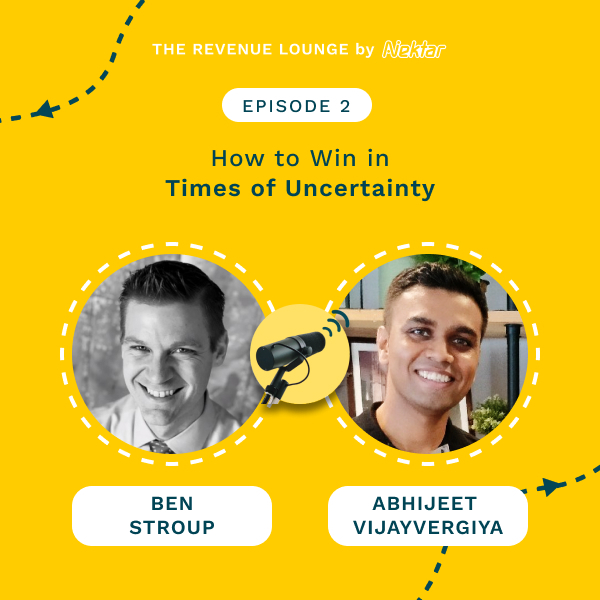
Ep #2: How to Win in Times of Uncertainty
Listen Now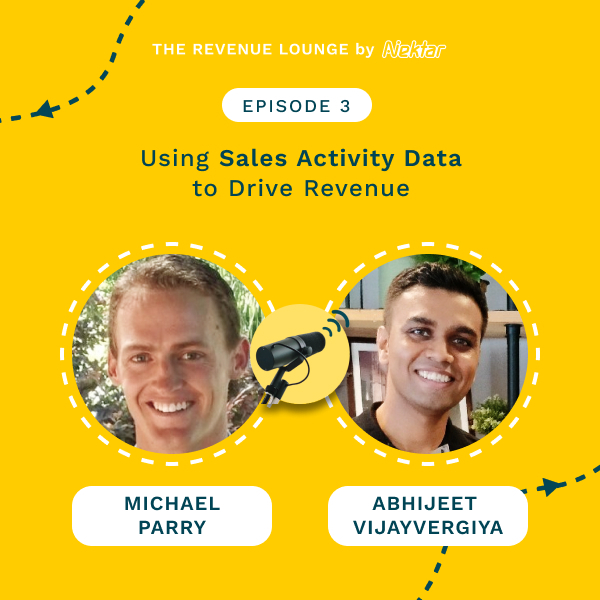
Ep #3: Using Activity Data to Drive Sales Productivity
Listen Now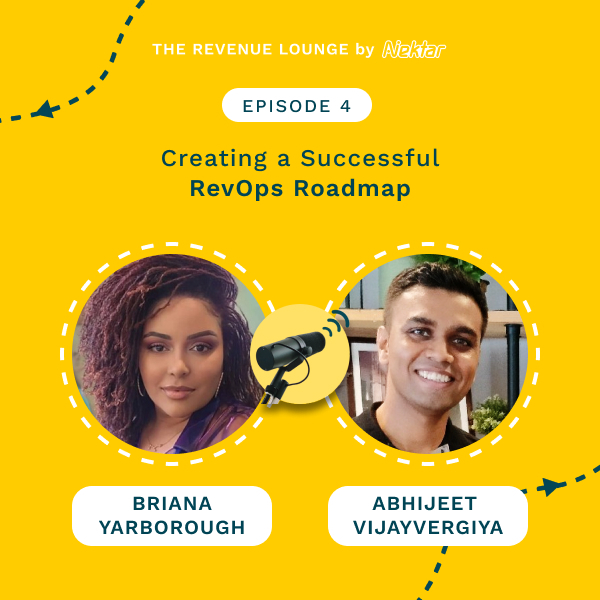
Ep #4: Creating a Successful RevOps Roadmap
Listen Now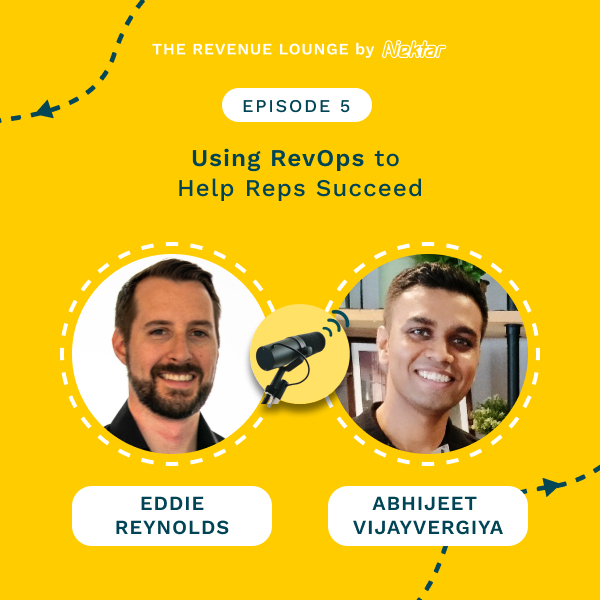
Ep #5: Using RevOps to Help Reps Succeed
Listen Now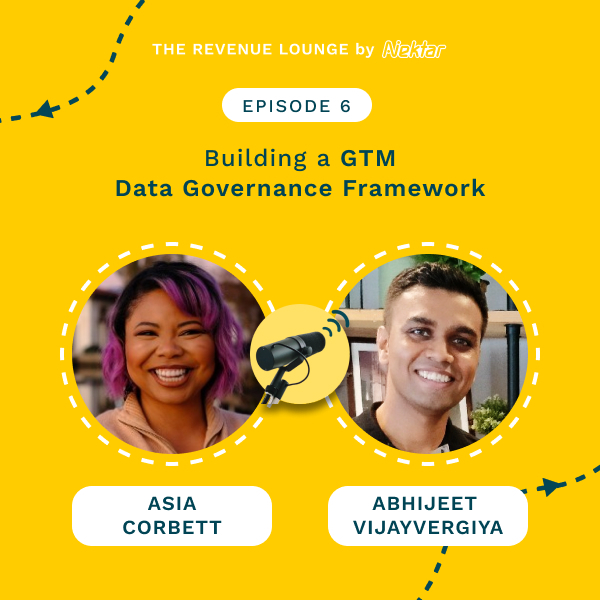
Ep #6: Building a GTM Data Governance Framework
Listen Now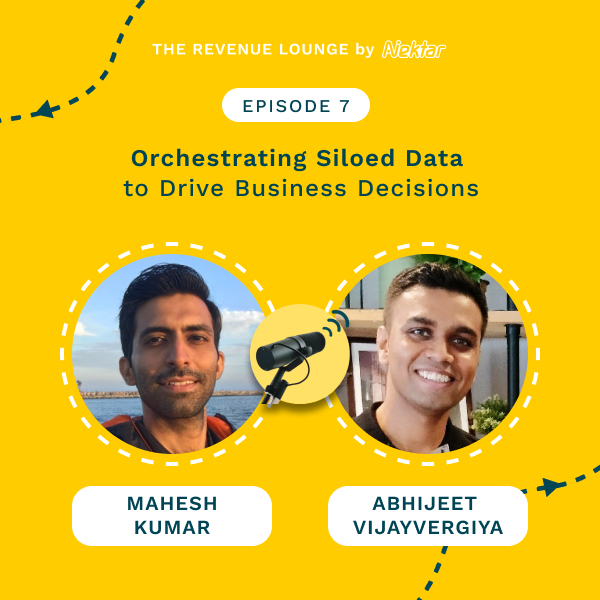
Ep #7: Orchestrating Siloed Data to Drive Business Decisions
Listen Now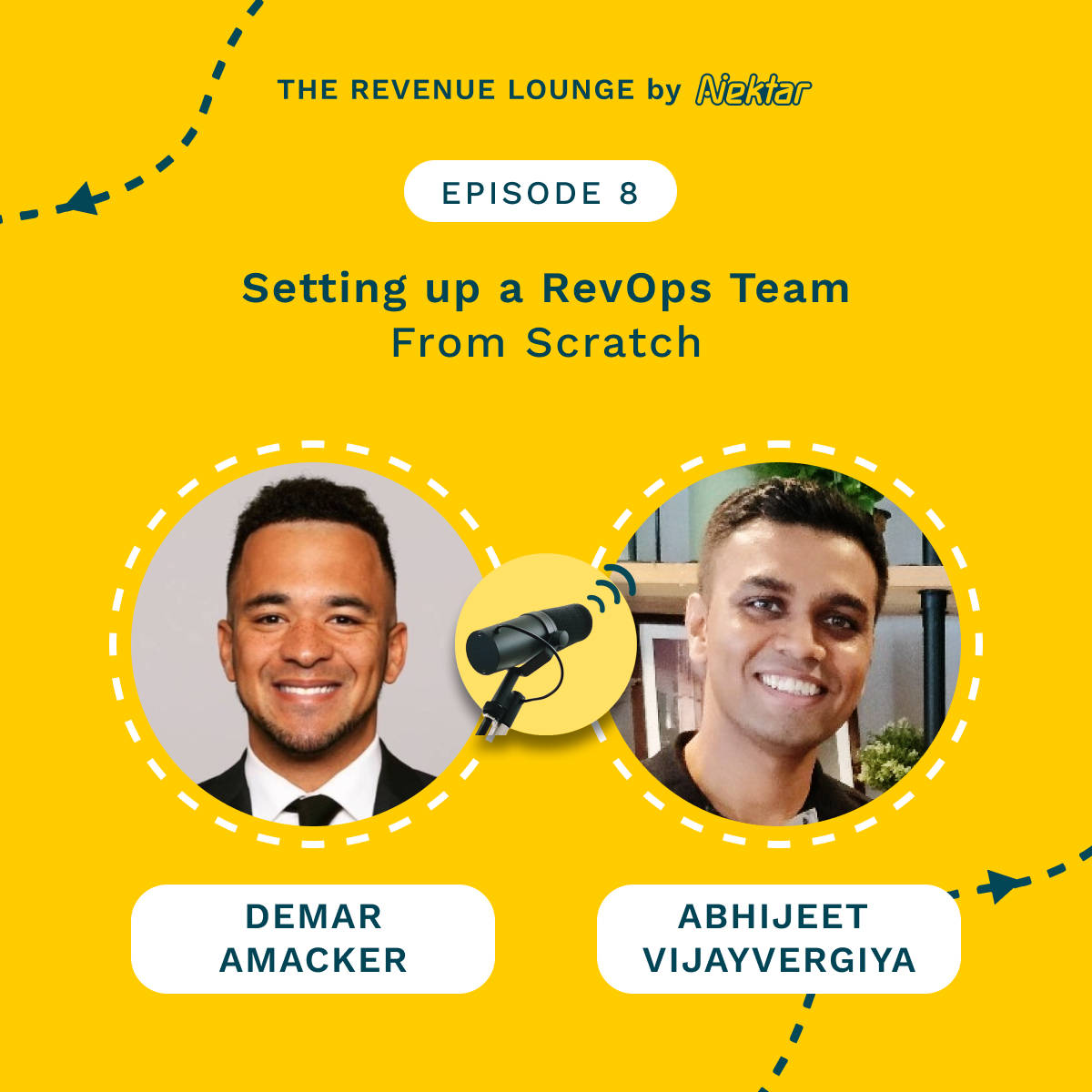
Ep #8: Setting Up a RevOps Team From Scratch
Listen Now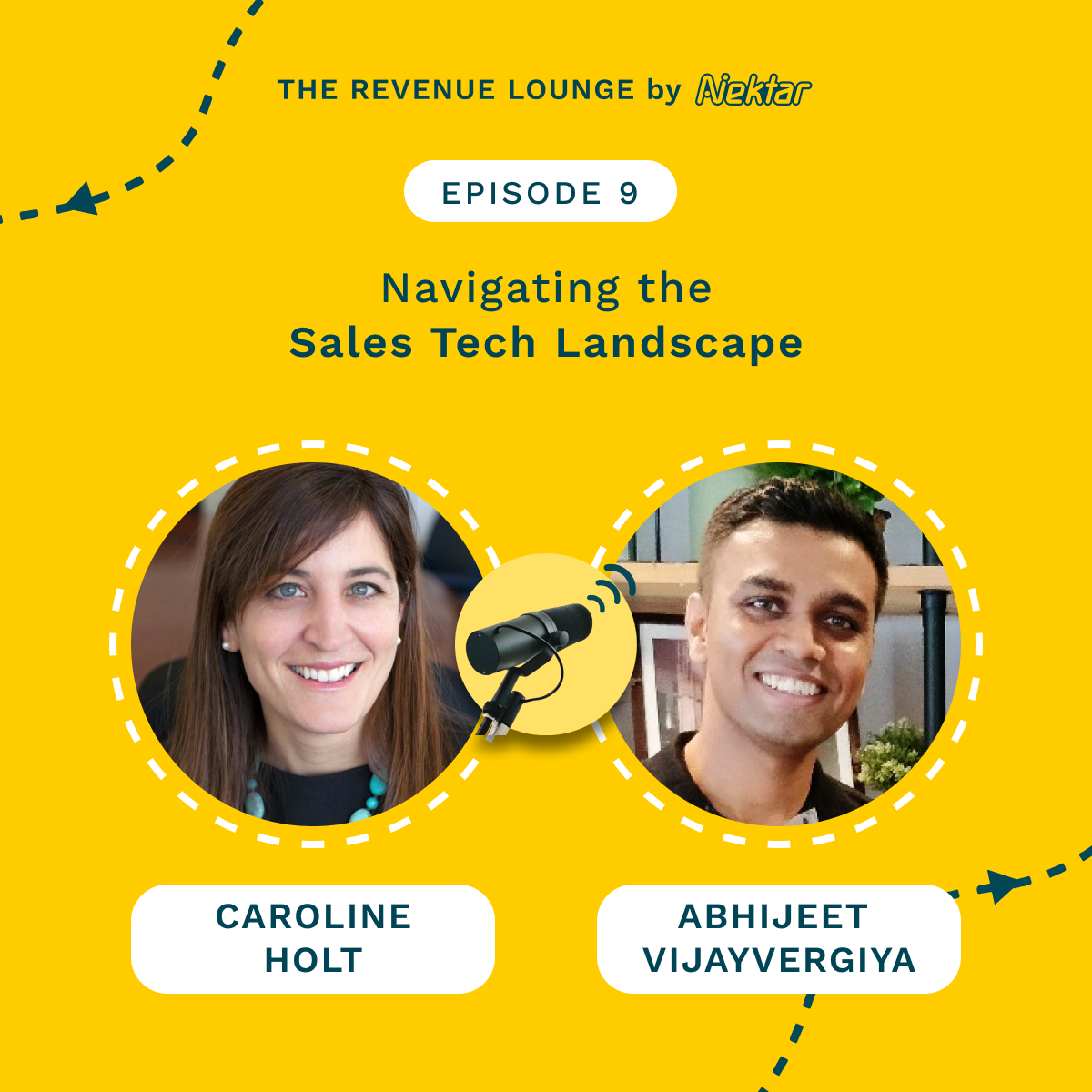
Ep #9: Navigating the Sales Tech Landscape
Listen Now